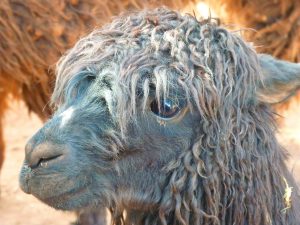 The months of April and May are the beginning of the harvesting season. Alpacas have been growing their fleece all year and we are now ready to harvest. Sheering has begun on Vancouver Island. The alpaca fleeces are long and still clean. The longer we wait, the more the animals roll in dust and the fiber gets dirty.
The months of April and May are the beginning of the harvesting season. Alpacas have been growing their fleece all year and we are now ready to harvest. Sheering has begun on Vancouver Island. The alpaca fleeces are long and still clean. The longer we wait, the more the animals roll in dust and the fiber gets dirty.
It is Raining Again
 Alpacas are shorn once a year. The harvesting season on Vancouver runs from mid-April to mid-July. The weather plays an important role in choosing the shearing date. April is normally sunny and dry in British Columbia however this year it has been raining more than usual and the temperature is still low for this area. We had one day over 20⁰C since the beginning of the year. Wet or humid alpaca fiber is hard to shear. When it is wet and long, shearing is dangerous. The animal’s skin is very delicate and the weight of the fiber will pull on the skin. The shear blades will easily cut the skin. I shear the alpacas when they are dry.
Alpacas are shorn once a year. The harvesting season on Vancouver runs from mid-April to mid-July. The weather plays an important role in choosing the shearing date. April is normally sunny and dry in British Columbia however this year it has been raining more than usual and the temperature is still low for this area. We had one day over 20⁰C since the beginning of the year. Wet or humid alpaca fiber is hard to shear. When it is wet and long, shearing is dangerous. The animal’s skin is very delicate and the weight of the fiber will pull on the skin. The shear blades will easily cut the skin. I shear the alpacas when they are dry.
Length of the Fiber
The length of the fiber is a genetic trait. The preferred length is between 2 and 4 inches. Some animals grow more than 6 inches in one year. Other animals grow less than 2 inches. These animals can be shorn every other year when their health permits. The fleece of a suri alpaca is different from the huacaya alpaca. Its fiber falls on each side of the back. The huacaya fiber is fluffy and grows perpendicularly to the body. Suri alpacas can be shorn once every other year.
Cleanliness
Alpaca fleece will protect the animal from cold and rain during the winter season. The skin normally remains dry under a couple of inches of fiber. The fleece becomes too hot in the summer. An alpaca will roll in dust and put their feet in water (often their water bucket) to keep their temperature comfortable. When we shear them before the hot summer days, the shorn fiber contains less vegetation and sand. The animals will still roll when shorn but the dust will not remain. When the alpacas are shorn too late in the season, the fleece will contain much more vegetation and sand will be present near the skin. Vegetation is the nightmare of the fleece processor and sand is annoying for the shearer. The sand dulls the blades rapidly and the shearer must change blades much more often.


Environment
A clean pasture will also contribute to clean fiber. Plants with thorny leaves or fruits should be avoided and removed. Some plants are even poisonous for alpacas like rhododendron. One leaf ingested will kill an alpaca. Shade areas in the pasture will help in comfort during warmer days. Large barns will also stay cool during the summer.
Shearing Services
If you have not done so, call a shearer soon to schedule a date. Alpacas need to be shorn once a year. They will feel much better and will remain healthy. Older animals can be shorn every other year when their fiber production is low. They will normally not suffer overheating and will have a thick enough coat to survive the winter. Suri alpacas can be shorn every other year when their fleece is used for products. When the fiber is not used for products, they should be shorn every year.
Have a great shearing season.
NicoAlpaca

Very interesting post – even though I’ve not thought about the alpaca fiber business before. This article raises two questions for me:
1 Does anyone make use of alpaca milk for human consumption or products?
2 How profitable is the business of owning and raising alpacas for their fiber?
Thanks,
Steve
To my knowledge, alpacas do not produce extra milk like cow do. They only produce enough for their cria (baby alpaca). I have not heard of anyone using alpaca milk for human uses. An alpaca business becomes profitable when you have enough high quality animals. The magic number I am aware of it around 40 animals. Below that, your fleece production is too low and the number of available animals for sale would also be too low. Money comes from raw fleece, products and animal sales.